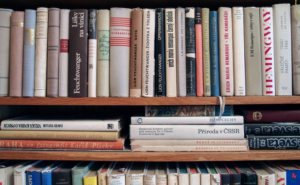14 February 2019
Cutting the books
How to cope with the tidy police.
By Frank O’Nomics
 How many times do you read a book? Apart from dictionaries most of us, once we have finished (or given up on) a book, rarely touch it again unless we are throwing it away or giving it to a charity shop. Why then do we devote acres of domestic space, which could be much more usefully employed, to literature? Given that we can download thousands of books to our ipads and kindles (other readers are available), there may not be any need to own hard copy at all. When the Netflix tidy-up guru Marie Kondo was recently quoted (wrongly it seems) as arguing that we need to keep no more than 30 books the reaction was surprising in its size and ferocity. The vocal majority claimed to place great value on their books and were extremely resistant to ditching any. Two questions arise – how do we defend our retention of books, and is there a rational way of deciding which to let go?
How many times do you read a book? Apart from dictionaries most of us, once we have finished (or given up on) a book, rarely touch it again unless we are throwing it away or giving it to a charity shop. Why then do we devote acres of domestic space, which could be much more usefully employed, to literature? Given that we can download thousands of books to our ipads and kindles (other readers are available), there may not be any need to own hard copy at all. When the Netflix tidy-up guru Marie Kondo was recently quoted (wrongly it seems) as arguing that we need to keep no more than 30 books the reaction was surprising in its size and ferocity. The vocal majority claimed to place great value on their books and were extremely resistant to ditching any. Two questions arise – how do we defend our retention of books, and is there a rational way of deciding which to let go?
The first question is easily addressed by looking at the passionate justification for literary hoarding sparked by Marie Kondo. At was almost as if you were asking people to choose between their babies. While they may never pick them up again, many regard books as a memento of a positive experience, or a trophy for their endeavour and persistence. For others it is a way of demonstrating their intellect or compassion. Having A Brief History of Time, Chaos Theory or anything by Proust sits as a testament to one’s learning – even though these are books that tend to be owned rather than read (a phenomenon know as tsundoko, in case you wondered). There are others who see books as an investment or as works of art that enhance the aesthetic quality of a room.
These are all fairly obvious justifications for our libraries, but there are also some good reasons for retaining clutter in general. Tim Hartford covered much of this in his recent book The Art of Messy and there is a wealth of academic study to support the view that a degree of disorganisation helps intellectual stimulation and may, perversely, increase efficiency. Researchers at AT&T Labs found that those who were most assiduous in their filing tended to file prematurely and hence a lot of useful material was lost amongst the dross. Extrapolate to the disposal of books and you can see that there is a great risk of getting rid of works that you will ultimately find useful in an effort to be tidy.
That is quite a lot of reasons for keeping our book collections, but there is clearly a limit dictated by space and safety, even if that limit may be a lot more than 30. While Marie Kondo may not have actually suggested reducing your library to 30 books, she has been seen recommending the wholesale dumping of literature on the basis of “will these books be beneficial to your life moving forward”. If nothing else there is at least virtue in taking more books to the charity shop, thereby benefiting a good cause and allowing others to appreciate your exceptional taste. So how do you go about deciding what to keep? You could book the services of a de-cluttering expert (yes, such people exist) at a cost of around £40 per hour. Alternatively, there is an economist who can help. Yukio Noguchi’s original thesis applied to files, but can just as readily be used for books. Rather than ordering our shelves according to the alphabet, genre or the colour of the spine, Noguchi’s theory suggests putting each book back on the extreme left of the shelf each time it is looked at. Over a period of time those books which collect at the far right of the shelf are those which are redundant and can be taken to the charity shop. The only other decision to be made is – how big should the shelf be? For most of us it seems that it will contain a lot more than 30 books.
The comedian Barry Humphries (alter egos Dame Edna Everage and Sir Les Patterson) is a self-proclaimed ‘bibliomaniac’, owning around 25,000 books all contained in his London house. Many of these books are first editions and the collection is very valuable. Asking him to slim the collection down to 30 would probably result in undermining the value of rare books and prompt an assault with a dangerous gladioli. Marie Kondo, who has stated that 30 is merely her own personal preference for the maximum number of books to keep, has so far sold an impressive 11 million copies of her own works worldwide – I wonder how many of those will make the de-clutter cut in a few years time?


